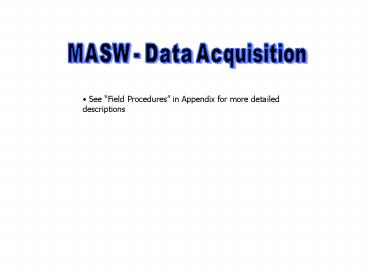MASW Data Acquisition
1 / 19
Title: MASW Data Acquisition
1
MASW - Data Acquisition
- See Field Procedures in Appendix for more
detailed descriptions
2
Field Parameters
- Offset
- Source and Receiver
- Recording Parameters
- Station and Record Numbers
3
Optimum Offset
- Avoid Near- and Far-Field (or Offset) Effects
- Near-Field Effects Nonhorizontal propagation
of surface waves - Far-Field Effects Contamination by body waves
and ambient noise
4
Near- and Far-Field Effects
- Near-Field Effects
- Non-planar Surface Waves
- Irregular Direction of Propagation
- Weak Amplitude
- Wavelength Dependent (The Longer Wavelength, the
Further Offset Needed) - gt 10 m ? A Rule of Thumb for Common Soil Site
- Far-Field Effects
- Body-Wave (e.g., Refraction) Domination
- Ambient Noise Domination
- Higher Mode Domination
- Low S/N
- lt 100 m ? A Rule of Thumb for Common Soil Site
5
Near-Field Effects
- Reduced Coherency
- Weak Amplitudes
- Most Wavelengths stabilized beyond 10 m from
source
Shot Gather
Swept-Frequency
6
Far-Offset Effects
S-Surface Wave, B-Body Wave and Ambient Noise,
FM-Fundamental , HM-Higher Mode
7
Optimum Offset
- Minimum Offset (the Source Offset) (X1)
- Anywhere in 5-10 m range
- Maximum Offset (the Farthest Offset) (X2)
- Anywhere in 50-100 m range
- Receiver Spacing (dx)
- Anywhere in 1-2 m range
8
Seismic Source
- Sledge Hammer
- Best Source ? Cheap, Portability, Easy to use,
Investigation depth of 10-20 m - Heavier Hammer (gt 5 kg) for deeper range (e.g., gt
10 m) - Lighter Hammer for shallower range
9
Seismic Source - Sledgehammer
10
Receivers
- Lower-Frequency Geophones
- 4.5 Hz Phone Best in price, performance
- Higher-Frequency Phones (e.g., 40 Hz) Limited
depth range (lt 10 m) - Phones higher than 100 Hz Absolutely Not
Recommended
11
Receivers
Shot Gather
Dispersion Curve
Comparison made by using a weight drop source
All with Weight Drop Source
12
Receiver Coupling (Spike vs. Plate)
Plate Coupling
Comparison made by using a weight drop source
and 4.5-Hz geophones
All with 4.5 Hz Geophones and 20-lb Sledgehammer
13
Recording Parameters
- Total Recording Time (T)
- 1000 ms (1 sec)
- Increase when length of receiver spread becomes
longer than normal - Increase if slower materials (i.e., softer soil)
- Sampling Interval (dt)
- 1 ms
- Decrease (e.g., 0.5 ms) if body waves are to be
utilized - Low-Cut Filter Out!
14
Field Parameters - Rules of Thumb
- Source 20-lb (10 kg) Sledge Hammer
- Receiver 4.5 Hz Geophones
- Total Channel At least 12 Channel
- Offsets
- 5 m minimum offset
- 0.5 m receiver spacing
- Maximum offset not to exceed 100 m
- Recording Parameters
- 1 ms sampling interval
- 1000 ms total recording time
- Low-cut filter out
15
Optimum Acquisition Parameters Table
16
Quality of Data (Records)
- Good Data Well-defined pie-shaped envelop
- Bad Data Irregular or incoherent waves
17
Station and Record Numbers
- Station Numbers
- Arbitrary numbers for surface coordination
- For example, 1001, 1002, 1003, etc., for line 1
- Record Numbers
- Data ID to correlate with field parameters
- Arbitrary numbers assigned by seismograph (file
name) - Can be reassigned at the beginning of processing
- Field Note
- Record number associated with station numbers for
source and receivers - All acquisition parameters
- Site map and photos
- Comments
18
Field Note Example Format
19
Station Number Field Coordinate































